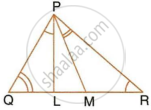Advertisements
Advertisements
Question
In ∆ABC, ∠B = 90° and BD ⊥ AC.
- If CD = 10 cm and BD = 8 cm; find AD.
- If AC = 18 cm and AD = 6 cm; find BD.
- If AC = 9 cm and AB = 7 cm; find AD.
Solution
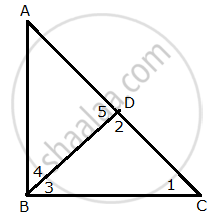
i. In ∆CDB,
∠1 + ∠2 + ∠3 = 180°
∠1 + ∠3 = 90° ...(1) (Since, ∠2 = 90°)
∠3 + ∠4 = 90° ...(2) (Since, ∠ABC = 90°)
From (1) and (2),
∠1 + ∠3 = ∠3 + ∠4
∠1 = ∠4
Also, ∠2 = ∠5 = 90°
∴ ∆CDB ~ ∆BDA ...(By AA similarity)
`=> (CD)/(BD) = (BD)/(AD)`
`=>` BD2 = AD × CD
`=>` (8)2 = AD × 10
`=>` AD = 6.4
Hence, AD = 6.4 cm
ii. Also, by similarity, we have:
`(BD)/(DA) = (CD)/(BD)`
BD2 = 6 × (18 – 6)
BD2 = 72
Hence, BD = 8.5 cm
iii. Clearly, ∆ADB ~ ∆ABC
`∴(AD)/(AB)=(AB)/(AC)`
`AD = (7 xx 7)/9`
= `(49)/9`
= `5 4/9`
Hence, `AD = 5 4/9 cm`
APPEARS IN
RELATED QUESTIONS
PQR is a triangle. S is a point on the side QR of ΔPQR such that ∠PSR = ∠QPR. Given QP = 8 cm, PR = 6 cm and SR = 3 cm.
- Prove ΔPQR ∼ ΔSPR.
- Find the length of QR and PS.
- `"area of ΔPQR"/"area of ΔSPR"`
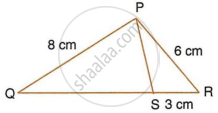
Given: RS and PT are altitudes of ΔPQR. Prove that:
- ΔPQT ~ ΔQRS,
- PQ × QS = RQ × QT.
In ∆ ABC, ∠B = 2 ∠C and the bisector of angle B meets CA at point D. Prove that:
(i) ∆ ABC and ∆ ABD are similar,
(ii) DC: AD = BC: AB
In ∆PQR, ∠Q = 90° and QM is perpendicular to PR. Prove that:
- PQ2 = PM × PR
- QR2 = PR × MR
- PQ2 + QR2 = PR2
In ∆ABC, right – angled at C, CD ⊥ AB.
Prove:
`"CD"^2 = "AD"xx "DB"`
In the given figure, AX : XB = 3 : 5
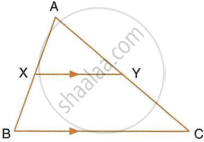
Find:
- the length of BC, if the length of XY is 18 cm.
- the ratio between the areas of trapezium XBCY and triangle ABC.
In the given triangle PQR, LM is parallel to QR and PM : MR = 3 : 4.
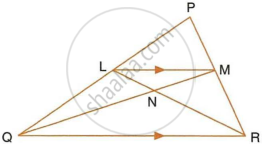
Calculate the value of ratio:
- `(PL)/(PQ)` and then `(LM)/(QR)`
- `"Area of ΔLMN"/"Area of ΔMNR"`
- `"Area of ΔLQM"/"Area of ΔLQN"`
In the following figure, AD and CE are medians of ΔABC. DF is drawn parallel to CE. Prove that :
- EF = FB,
- AG : GD = 2 : 1
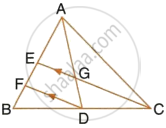
The ratio between the areas of two similar triangles is 16 : 25. State the ratio between their :
- perimeters.
- corresponding altitudes.
- corresponding medians.
In a triangle PQR, L and M are two points on the base QR, such that ∠LPQ = ∠QRP and ∠RPM = ∠RQP. Prove that:
- ΔPQL ∼ ΔRPM
- QL × RM = PL × PM
- PQ2 = QR × QL
